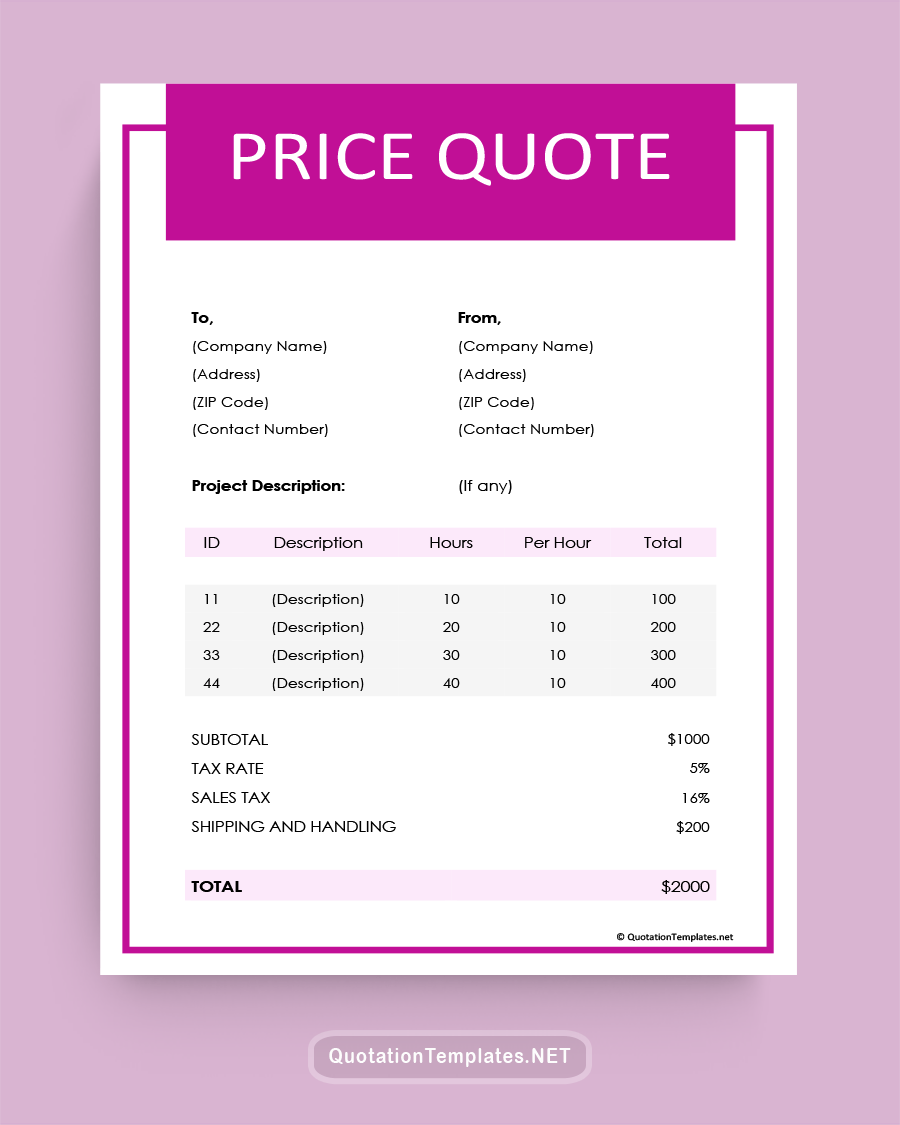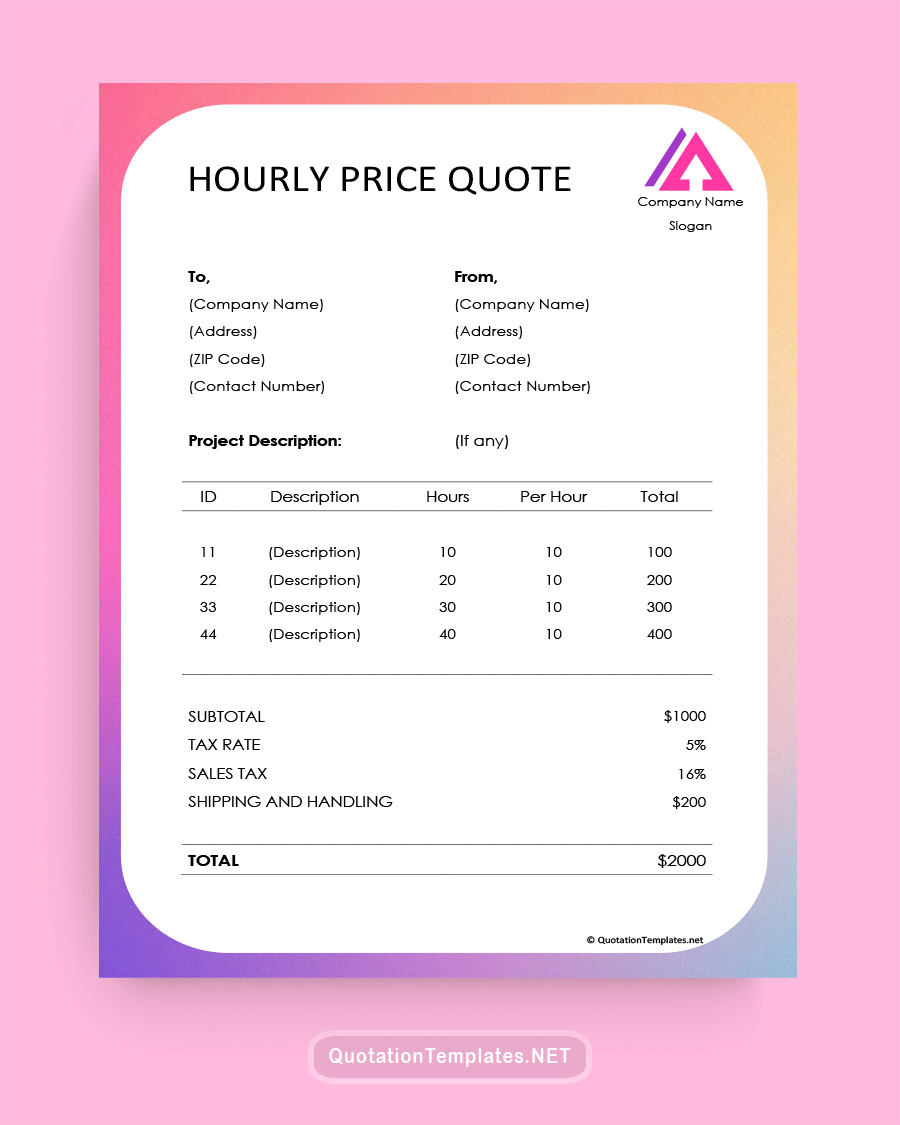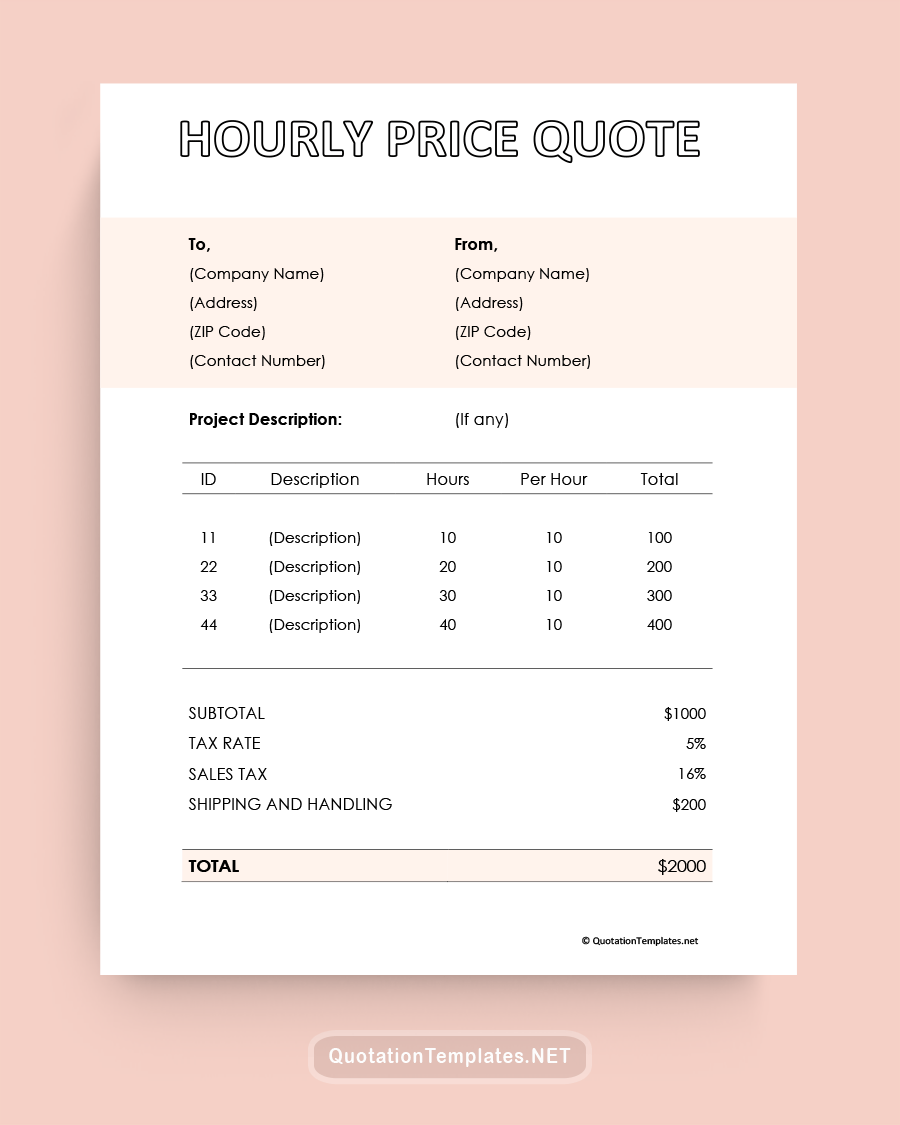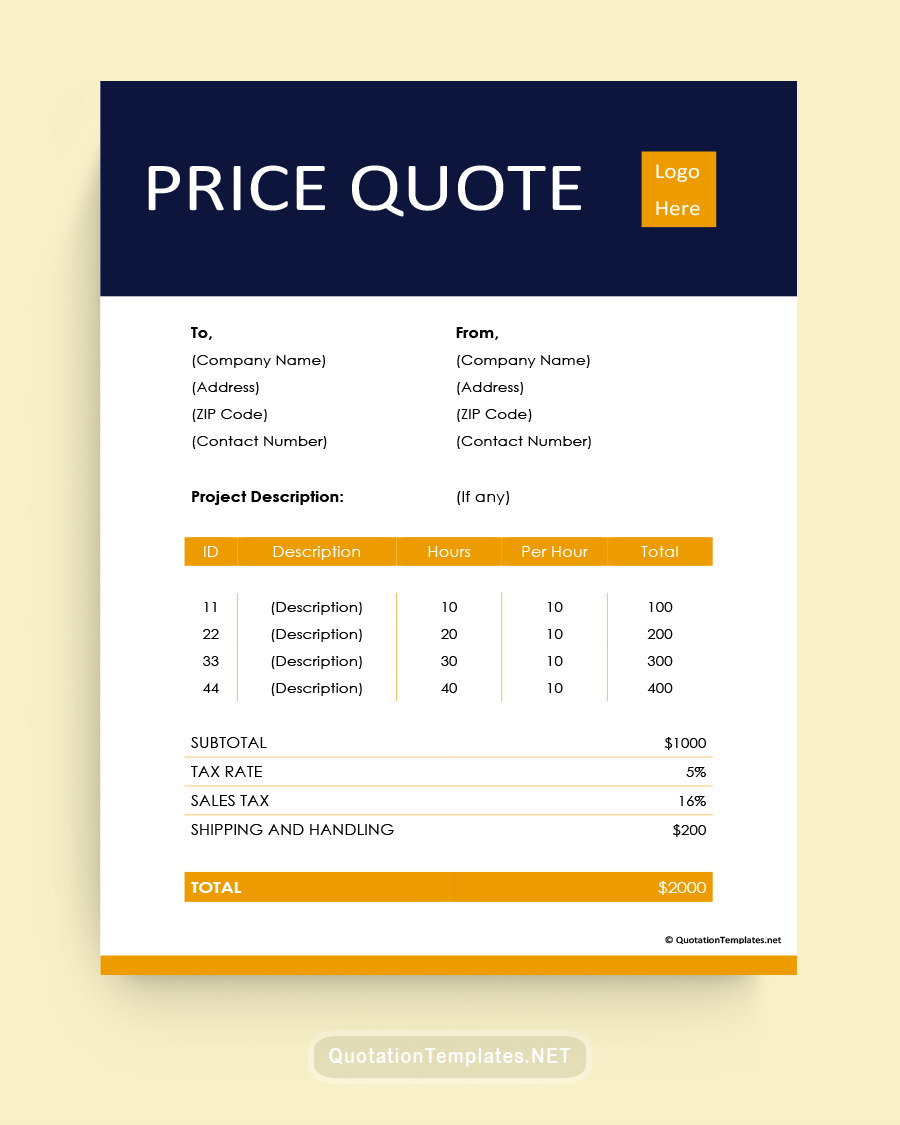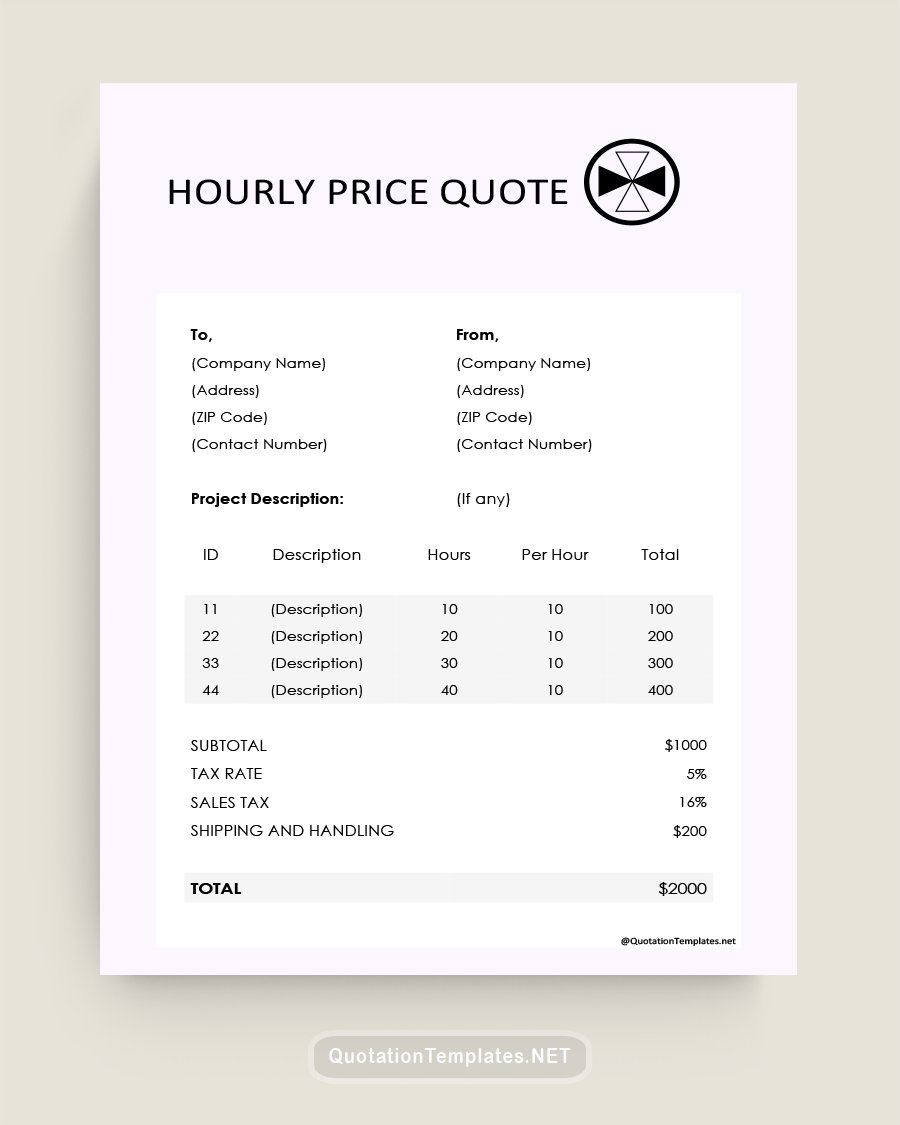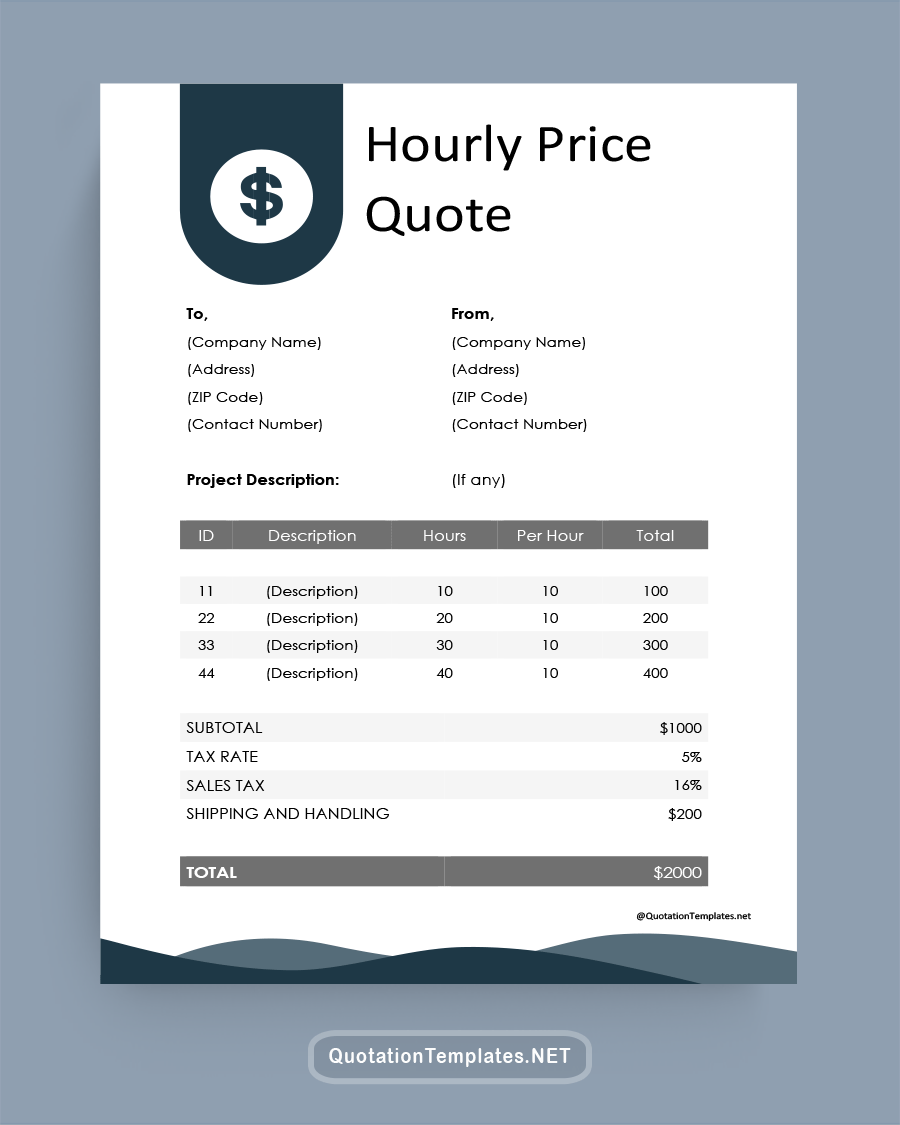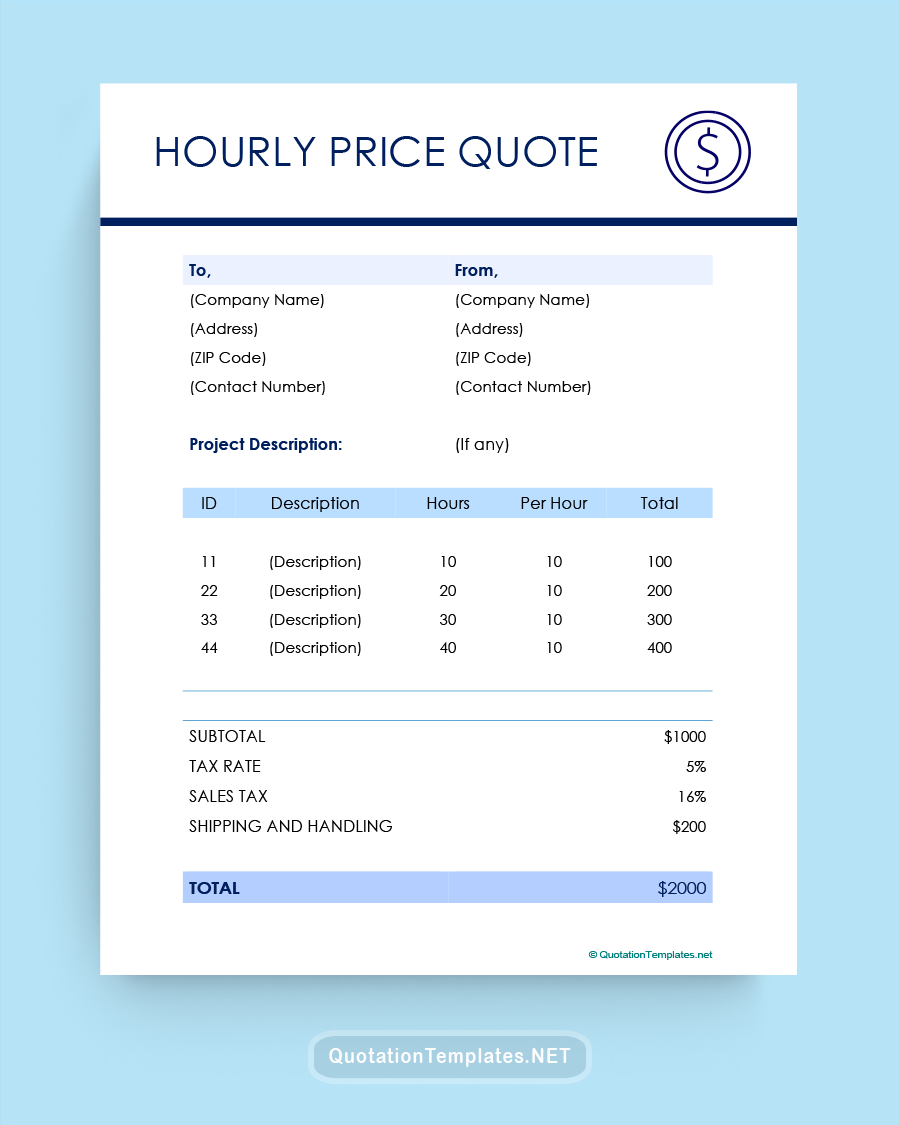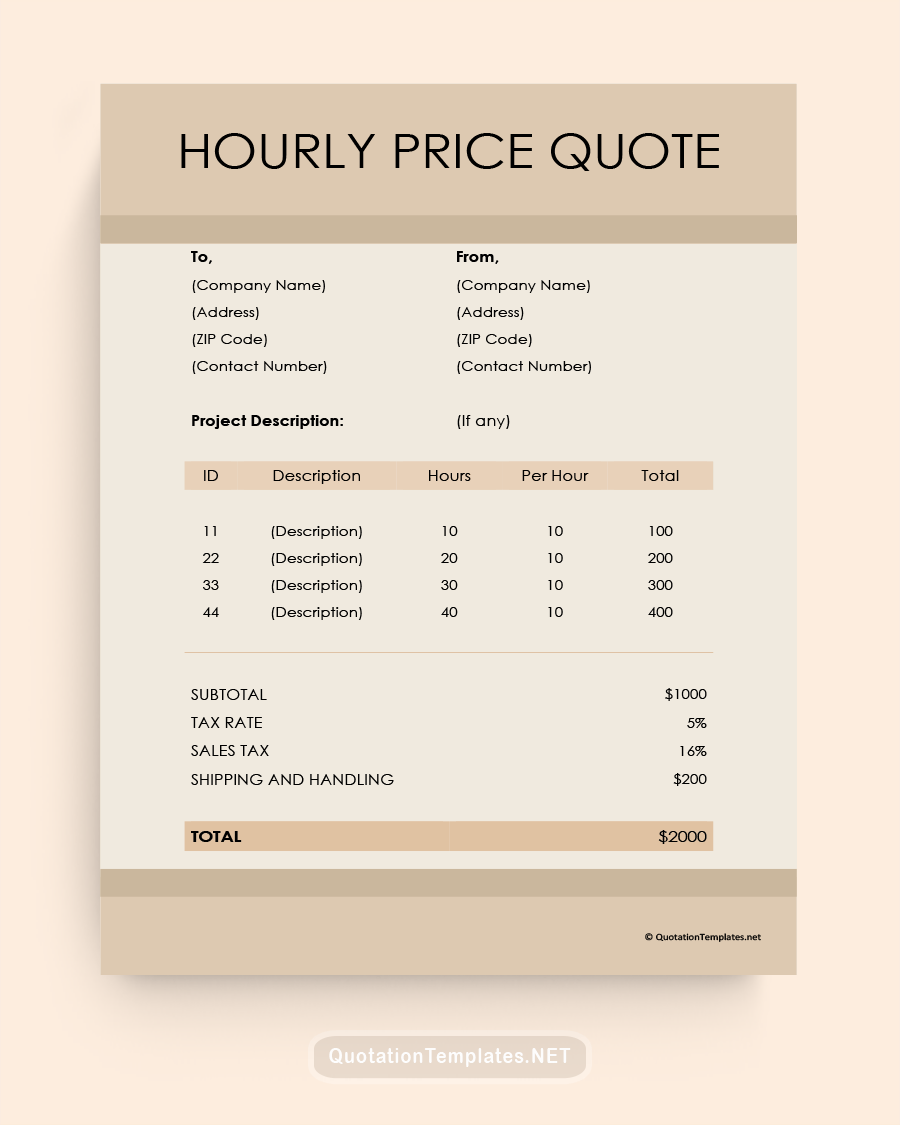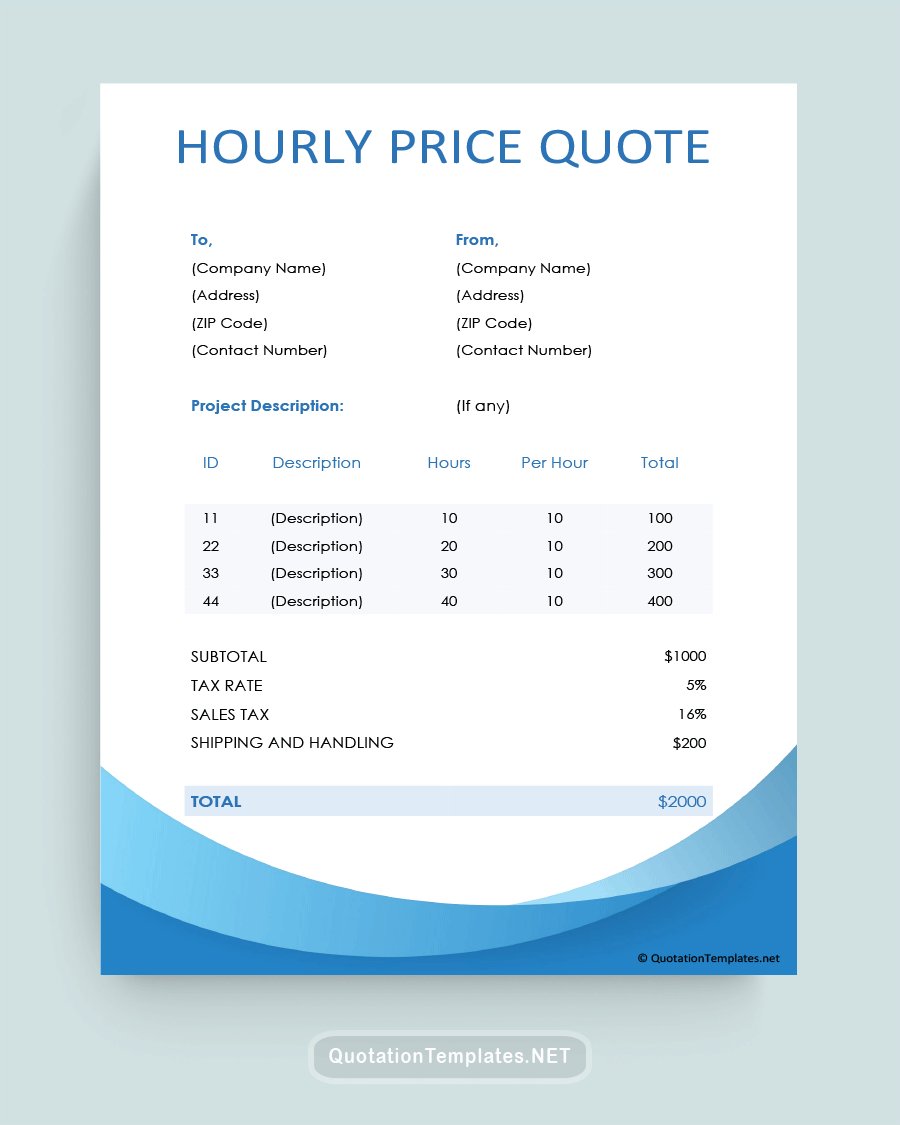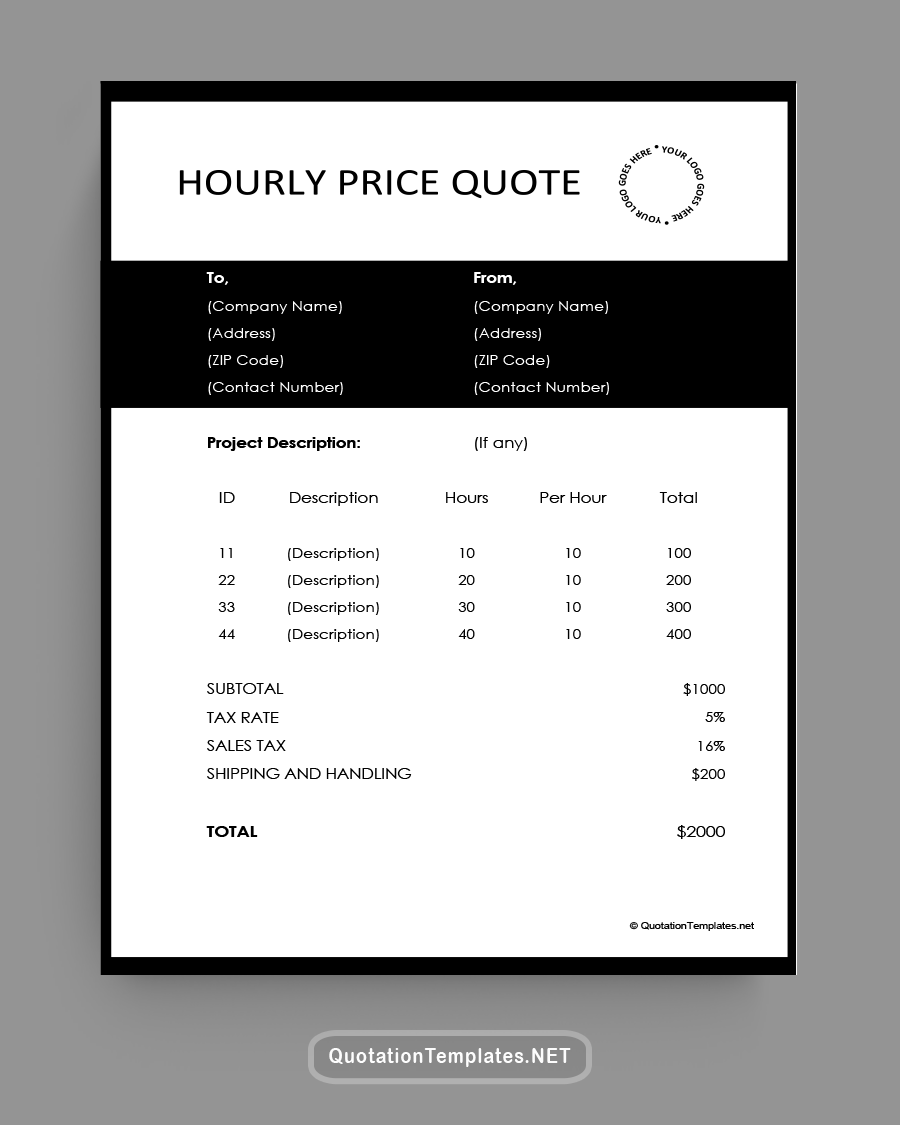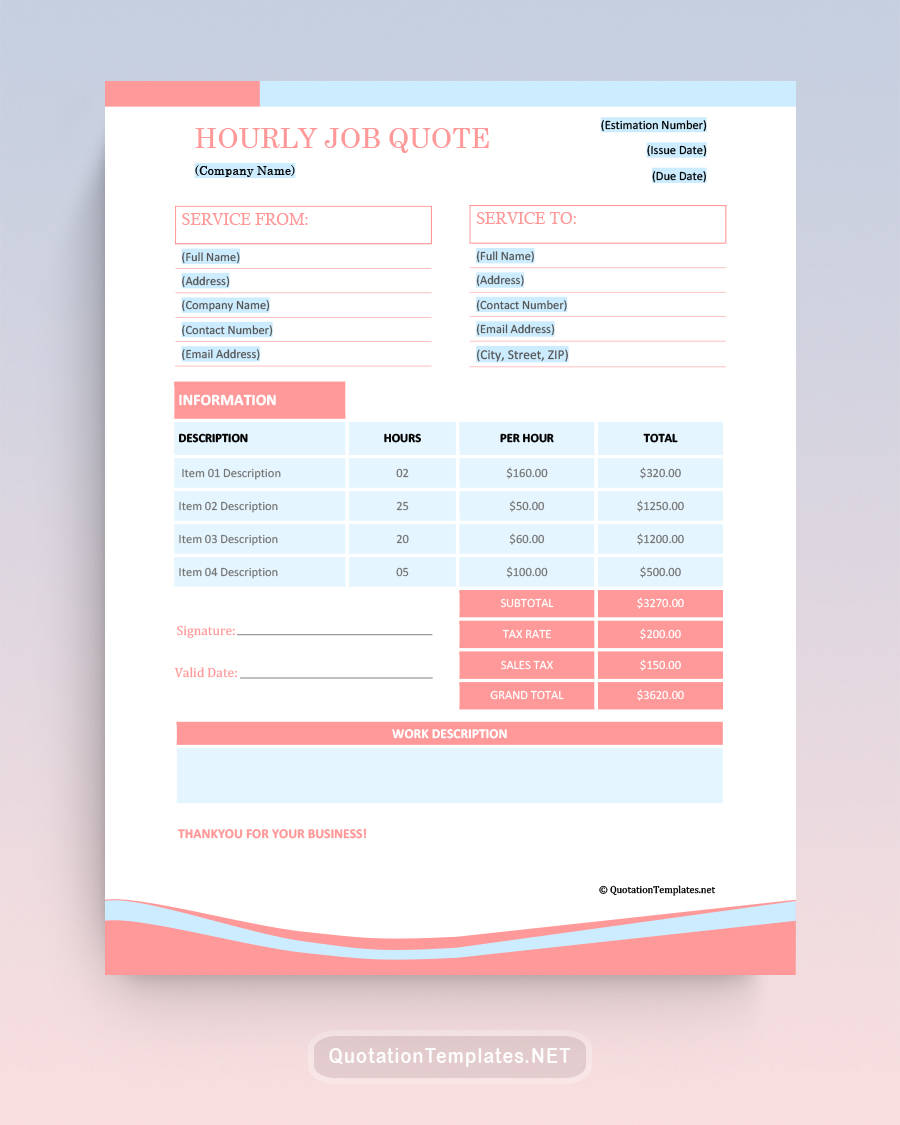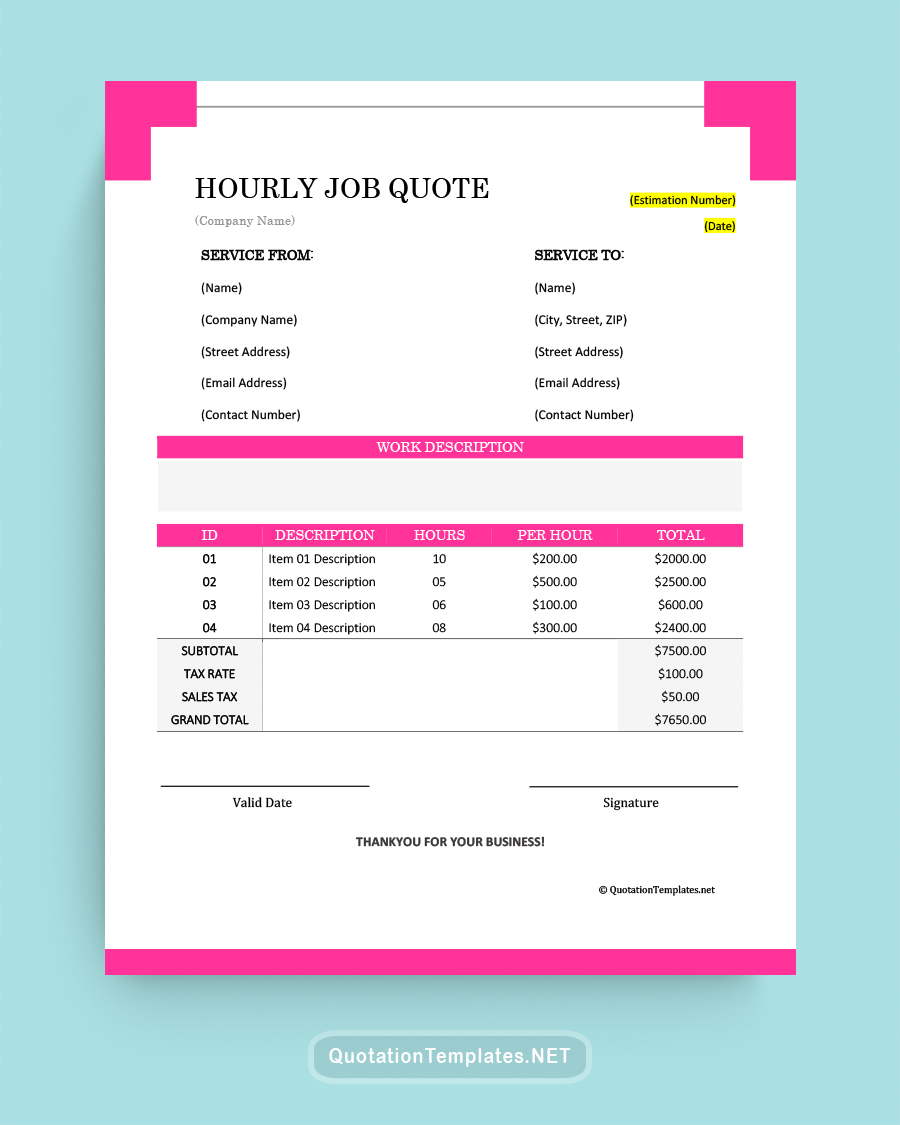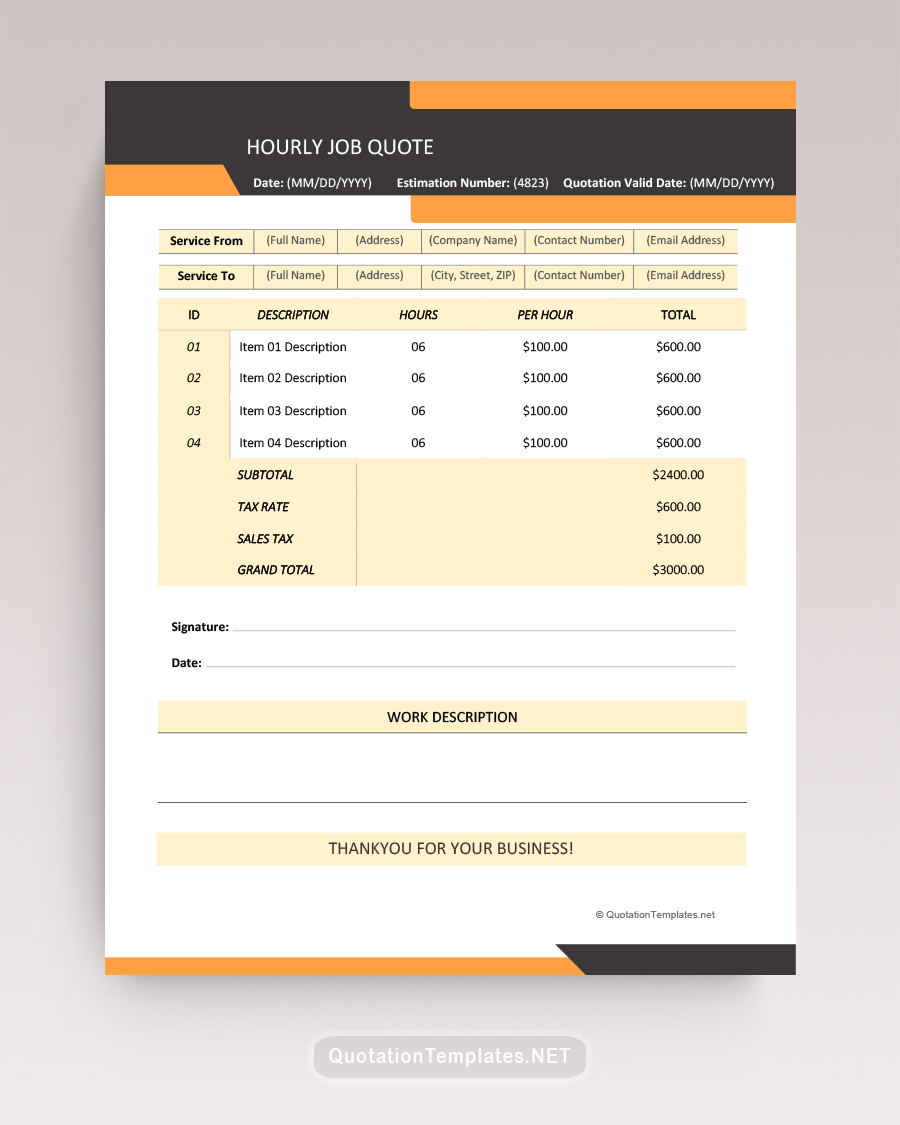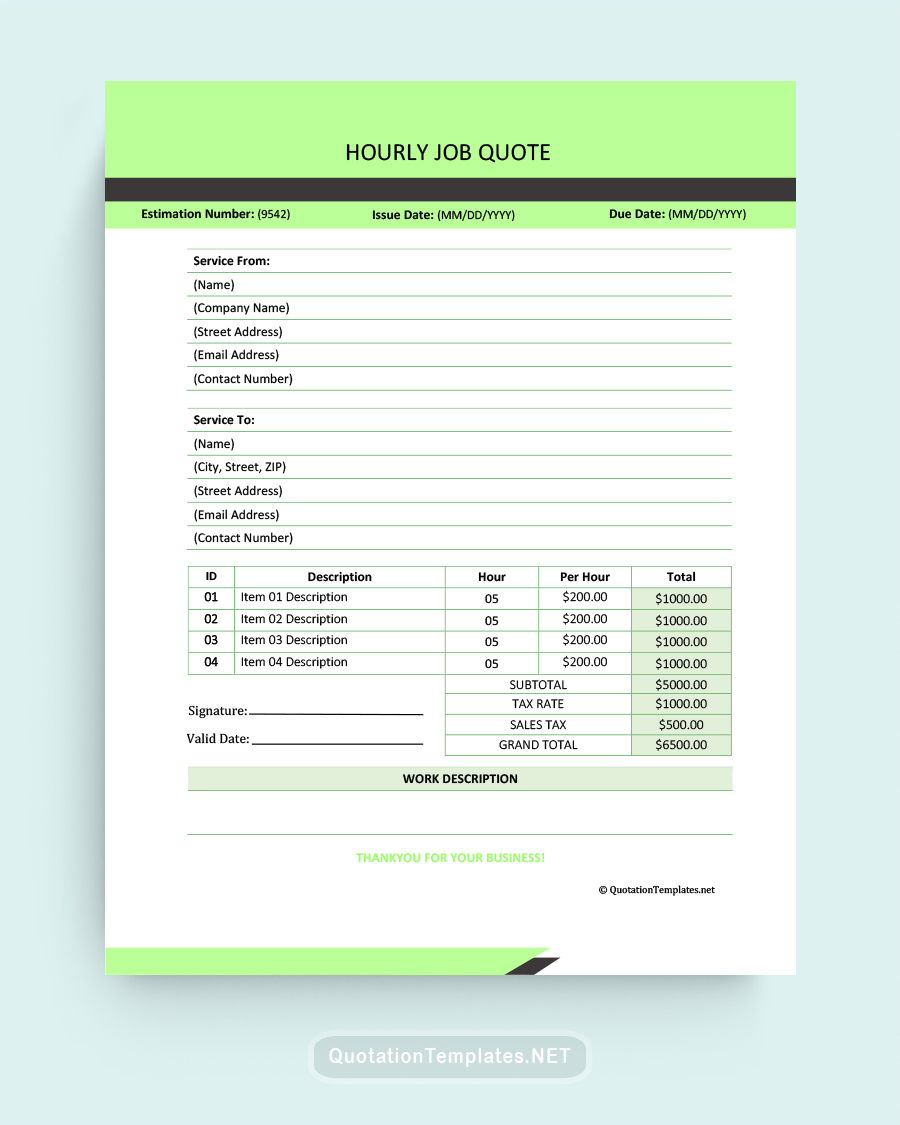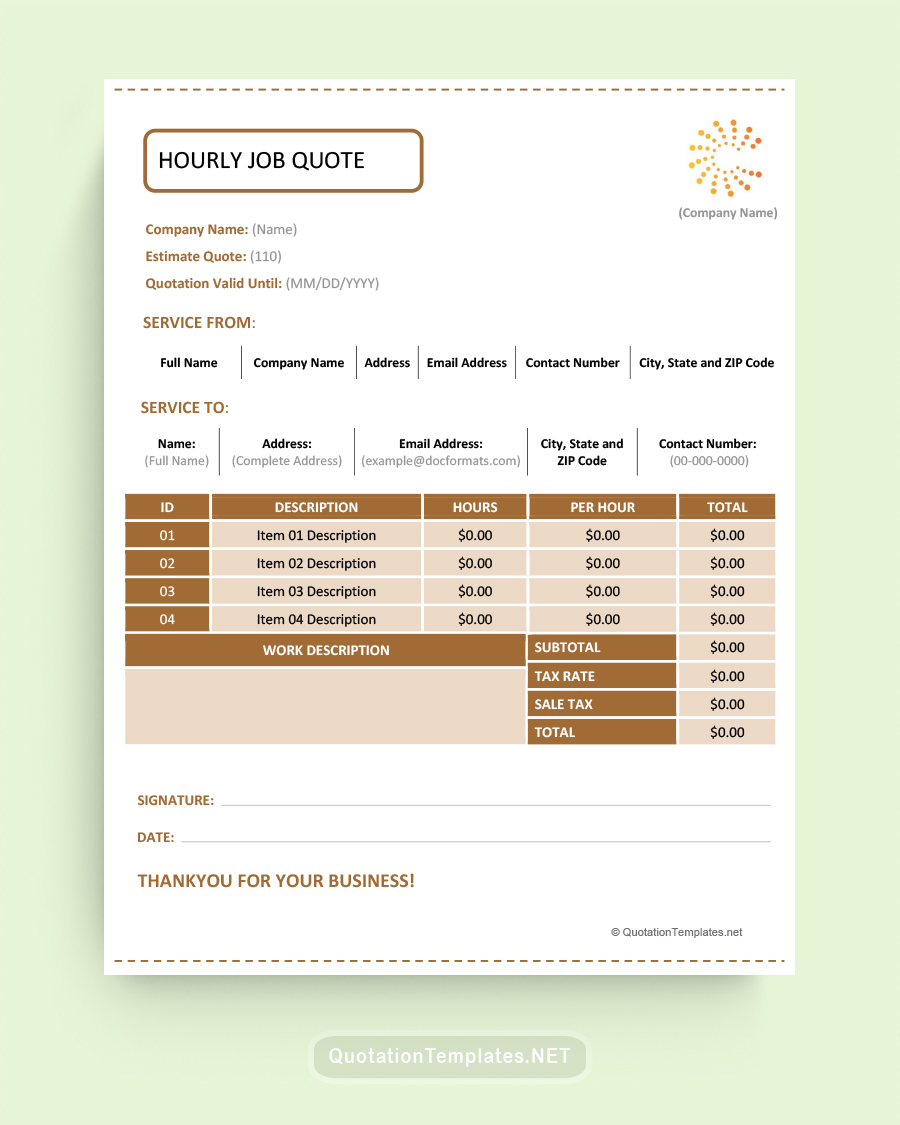Hourly Price Quote Templates
Charging by the hour is one of two fundamental ways businesses deal with customers. Running a business has many aspects and details that a savvy professional must stay on top of to succeed. Having an hourly price quote template on hand is one way to help keep on top of the day-to-day needs of your clients and potential future clients. People want to know the going rate for your time or staff. When they ask for a quotation, also called a price quote, they are looking at what your services cost because they are interested.
A well-put-together quote is essential when people make inquiries. If you have to stop to create a new document from scratch every time someone asks you for this information, you look disorganized and unprofessional. People will automatically value your services less than they would if you hand them a clean, concise hourly price quotation that you only have to print off or email on request.
What is Hourly Price Quote?
Hourly price quote is the amount of money a contractor or company charges for one hour of labor. The value of the product or service provided the cost of labor and materials, travel time (if any), and profit all factor into how much to pay for an hour of someone’s time. When shopping around and comparing rates and services, someone asks for a price quotation. Looking at rates from various businesses is a savvy way to get the most for your money as a customer. For businesses, an hourly rate is often the best way to ensure you get fair value for labor over long-term projects.
What Is an Hourly Price Quote Template?
An hourly price quotation template allows a company or contractor to easily give potential clients the information they need about the cost of a job. It’s essential to have a simple, professional format that clarifies what you do and what you charge for it. This can be a flat hourly rate for work or several different services offered at different prices. Businesses with multiple employees should note different amounts for having one worker versus a whole crew, and specialists typically get paid at a higher rate.
Essential Elements of an Hourly Price Quote Template
The essential elements of an hourly price quotation template are simple. You need to provide information about who you are, what you do, and how much it costs. This sheet needs to be organized, so it’s straightforward enough for anyone to understand at a glance.
- Your business name
- Your Name and Position
- Business contact information, including address, website, email, and phone number
- Logo
- The header specifies that this is an hourly price quotation
- A clear description of the services or products you will provide
- Itemized list of specific actions or work you agree to and your estimate of how long it will take
- Cost per hour for each part of the job, whether this is a single item or the client wants a variety of services
- List the price for each estimated hourly rate
- Subtotal
- Taxes and fees
- Total
- A brief professional closing note such as “Thank You For Your Business,”
- Signature
- Date
- (Optional) You may want to add a time limit on the offer, especially if you work in a field where materials costs fluctuate often.
How to Calculate Your Hourly Rate
There are three primary considerations in calculating the hourly fee. First, how much should you be paid for your time? Are you an expert or someone who possesses exceptional skills, offers a unique product, or has extensive experience in the field? What are other people who do the same job being paid for their time?
Secondly, you need to tack on any fees for expenses like travel, materials, and tools. Your equipment can be simple or complicated. Likewise, you may need to use a lot of electricity or parts or provide a finished physical product. Customers should be paying a fair rate for your supplies, and you shouldn’t lose money if the job is further away.
Finally, you need to include perceived value. For example, suppose you make custom garden sculptures and are well known for your complex or beautiful work. In that case, the perceived value of this art form is much higher than if you were charging an hourly rate to take molds and pour replicas of existing statuary. An important thing to know about perceived value is that you and your client both need to value the work you do for them. Don’t undersell your labor or allow anyone to talk you into giving it away for less than the going rates.
Perceived value can also be affected by how you present yourself. Having your hourly price quotation template ready to fire off in an email or print on demand for a curious in-person customer can add value because it helps you look competent. Add the perceived value, hourly rate, travel time, fees like taxes, and materials together and divide by a fair estimate of how long the project should take you to come to a reasonable hourly rate.
Flat Price Vs. Hourly Price
Flat prices Vs. Hourly prices are two different models for how to charge customers. While both are valid, which one you choose should reflect the type of work you are doing, and ultimately it needs to give you fair compensation for the project. For example, a flat rate is what you see on store shelves where people buy lots of similar products or duplicates of the same product for a standard fee. This model works well for bulk items with standardized production costs like materials, shipping, and labor.
You often see hourly prices for services or custom projects made by artisans. Examples of hourly fees include housecleaners or wedding musicians like bands and DJs, who typically charge clients for the time they spend working. Doing this leaves leeway for both the person working and the client to add to the necessary time to complete a job or do something extra by adding time to the end.
The Benefit of Flat Rates
The most significant benefit to a flat rate is the fact that you can budget easily. You and the client know exactly what they will pay for the completed project. Deciding on a flat rate in advance leaves little room for confusion or negotiation.
The Downside to Flat Rates
The unfortunate thing about flat rates is that you may find yourself locked into an agreement to provide a good or service at that rate, even when it turns out to be less than it is worth. You still have a contract (verbal or on paper) if your project takes an extra ten hours or a lot more supplies and travel time than you planned. It’s best to sign a contract with a provision for these circumstances whenever possible.
The Benefit of Hourly Rates
Setting an hourly rate ensures you get paid for working time. Often this allows for more leniency in negotiating additional time to complete a project or do extra work. That makes clients happy and adds to your compensation.
The Downside to Hourly Rates
The downside to hourly work is that it may have time constraints. A client might expect you to be done in three hours when it actually takes five. They may have you leave the work unfinished, refuse to pay for more time, or complain about your work in various ways, like leaving a bad review. Alternately, you may be asked to stay until a job is done or commit more hours when you have other plans.
Hourly Price Quotation Format
The Hourly Price Quotation format below is a simple and effective form containing precisely the information your clients want. You can copy the format below and input your data to create an excellent hourly price quotation. Remember to keep things simple. Feel free to bookmark this page and keep a blank copy of the format available so you can adjust it as rates ad services change.
Your Business Name Here (If you have a logo, it goes on the other side of the sheet opposite this block of information, or you can swap it so the logo is on the left)
Your Name And Job (IE John Doe, Senior Manager)
Business Address
Business website
Phone Number
Hourly Price Quotation
Job Type and Description- For example, lawn care and gardening or professional caterers. Add a sentence or two describing specifically what your business can do and how many people it provides. The examples below are what you might see from a lawn and yard company, but you should put down the services you offer. Leave off anything that doesn’t apply, like the specialist service if you don’t have one.
Services & Hourly Rates
| Available Services | Rate |
| Service 1: Example Lawnmowing | $xx. xx |
| Service 2: Example Hedge Trimming | $xx. xx |
| Service 3: Example Garden Bed Creation | $xx. xx |
| Service 4: Example Yard/Property Cleanup for Event- Crew of 5 | $xx. xx |
| Service 5: Example Weeding Garden Beds | $xx. xx |
| Service 6: Example Chemical Pest and Weed Control (Specialist) | $xx. xx |
| Subtotal (If the customer specified the duration and services they need) | $xxxx. xx |
| Tax Rate | xx% |
| Total (Per Day, Week, etc. only if specified/requested) | $xxxxx. xx |
Thank You for Your Business, We/I Look Forward To Working With You
Your Name Here
(Signature) _____________
Note: The above rates are subject to change. This quote is the current rate as of (month and year) ______, ___.
Tips For a Better Price Quotation
There are a few basic things to remember about your price quotation template. These simple guidelines will make your price quote stand out from the competition.
- Keep it current. Make sure you update your rates regularly and check everything, including the date and email addresses, before you hand anyone the form.
- Check the rates in your area and ensure your prices are comparable, so you don’t lose out on business because of cheaper companies, but don’t devalue your work. People don’t always choose the lowest price, especially if you offer more services and come across as easier to work with and more professional.
- Don’t use abbreviations or confusing industry-specific terms when dealing with the public. Instead, explain it as though they do not specialize in your business.
- If you offer discounts, such as bulk rates, put that below the job description and above the rates list.
- Some businesses offer additional services on request. You can note this below the chart that lists your usual prices but above where it thanks the customer for their business.
- Don’t include unavailable services, only the things you can and will do.
- Make sure it’s as complete as possible.
- Skip any services the client isn’t interested in, even if you provide them. For example, if you do lawn care and yard maintenance, and part of your service includes tree trimming and removal, but your client has no trees, you can skip that line and just put down what they need.
- Don’t include any personal thoughts or opinions. Keep things professional.
- Avoid confusing fonts and fancy scrollwork so the potential client can read every word clearly.
- If you use colors, keep them on the logo and make sure it’s relatively minimal. You don’t want your form to look childish or distract from the purpose.
- Don’t offer a total or subtotal if they haven’t asked for specific services and durations. You can keep those columns blank and type TBD (To Be Determined).
- It’s okay and even advisable for businesses that have been around a long time to put down Estd. (Established date) or “Since” (insert the year you opened) because it shows you’ve been in your industry for a long time.
Final Thoughts
Convincing new clients to hire you is a part of every business. By having a professional, ready-to-go price quotation template on hand, you can quickly and easily explain to your potential customers what they can expect from you. Being transparent with people up front cuts down on any possible confusion and helps build trust. Repeat business is essential to most industries. Plus, people are more likely to recommend you and leave good reviews when they get good service at fair rates with no surprises.
